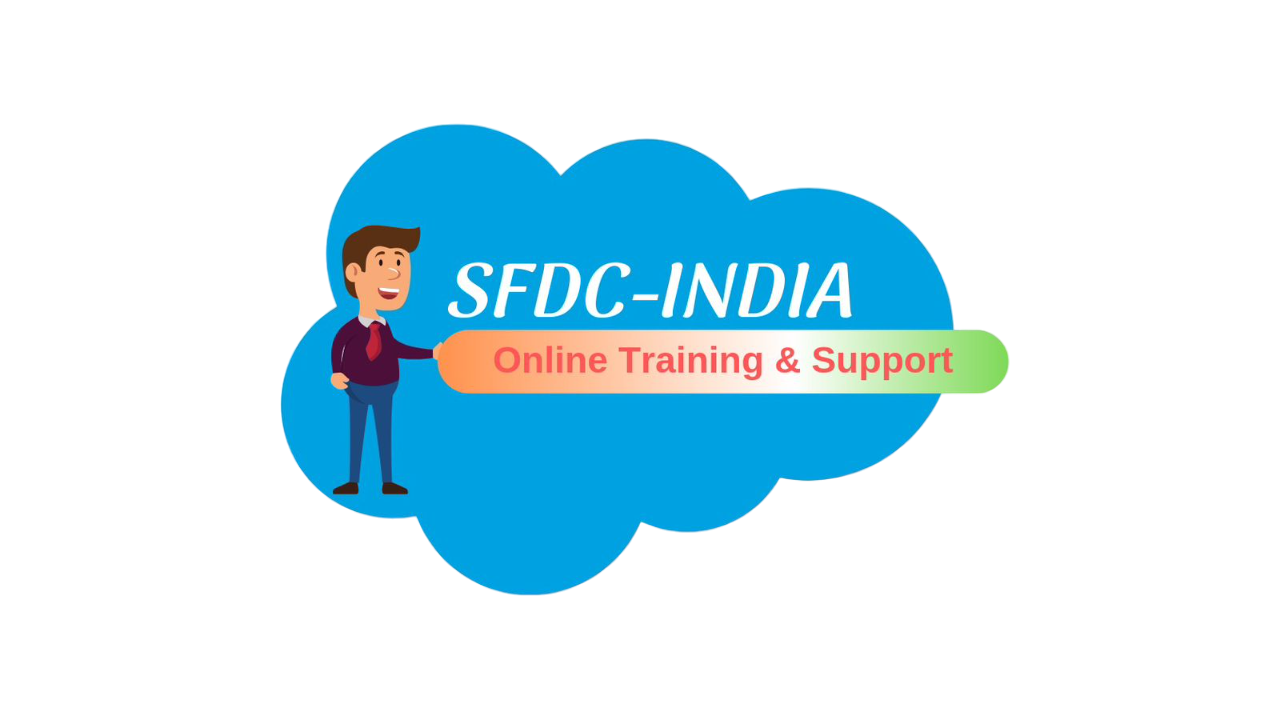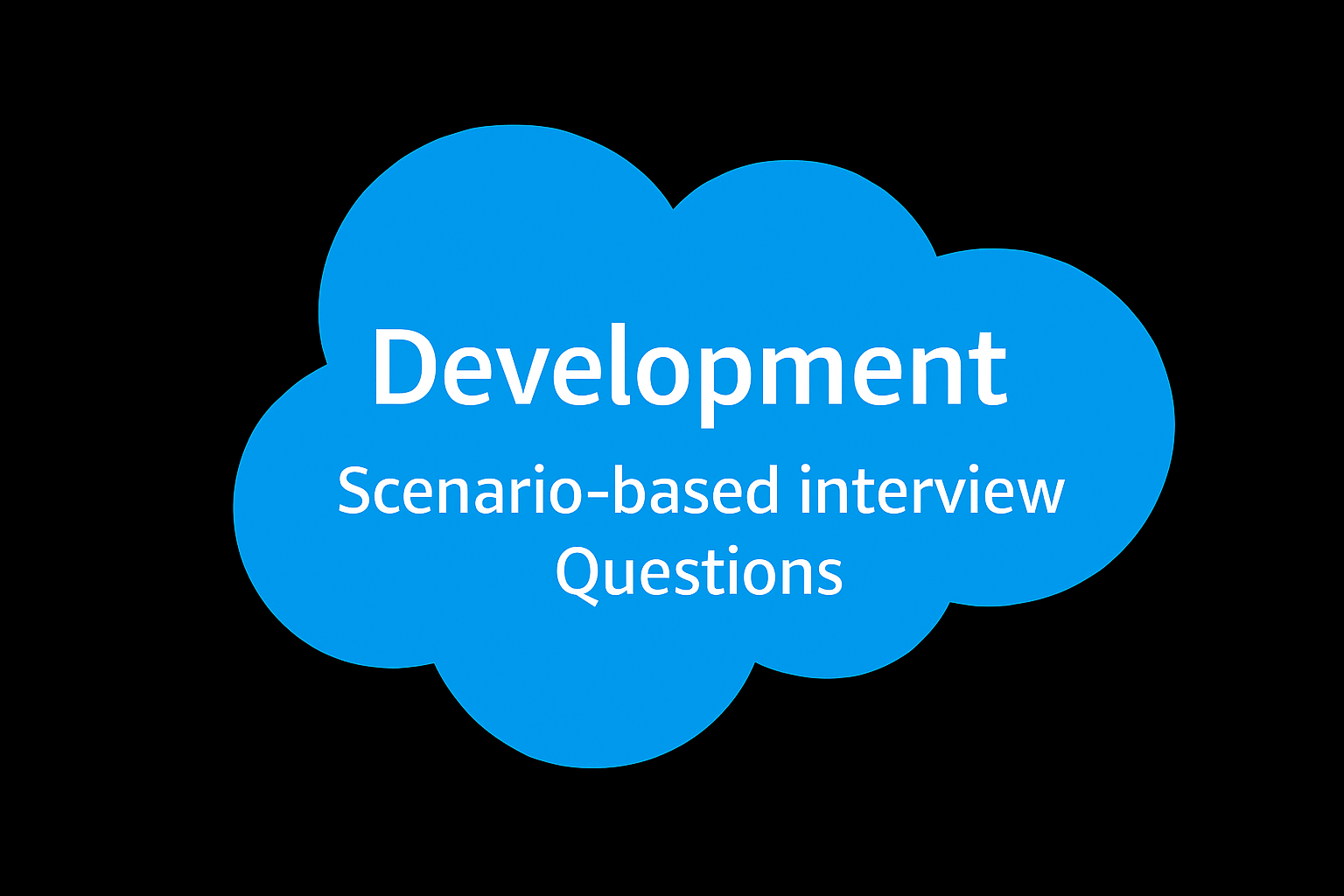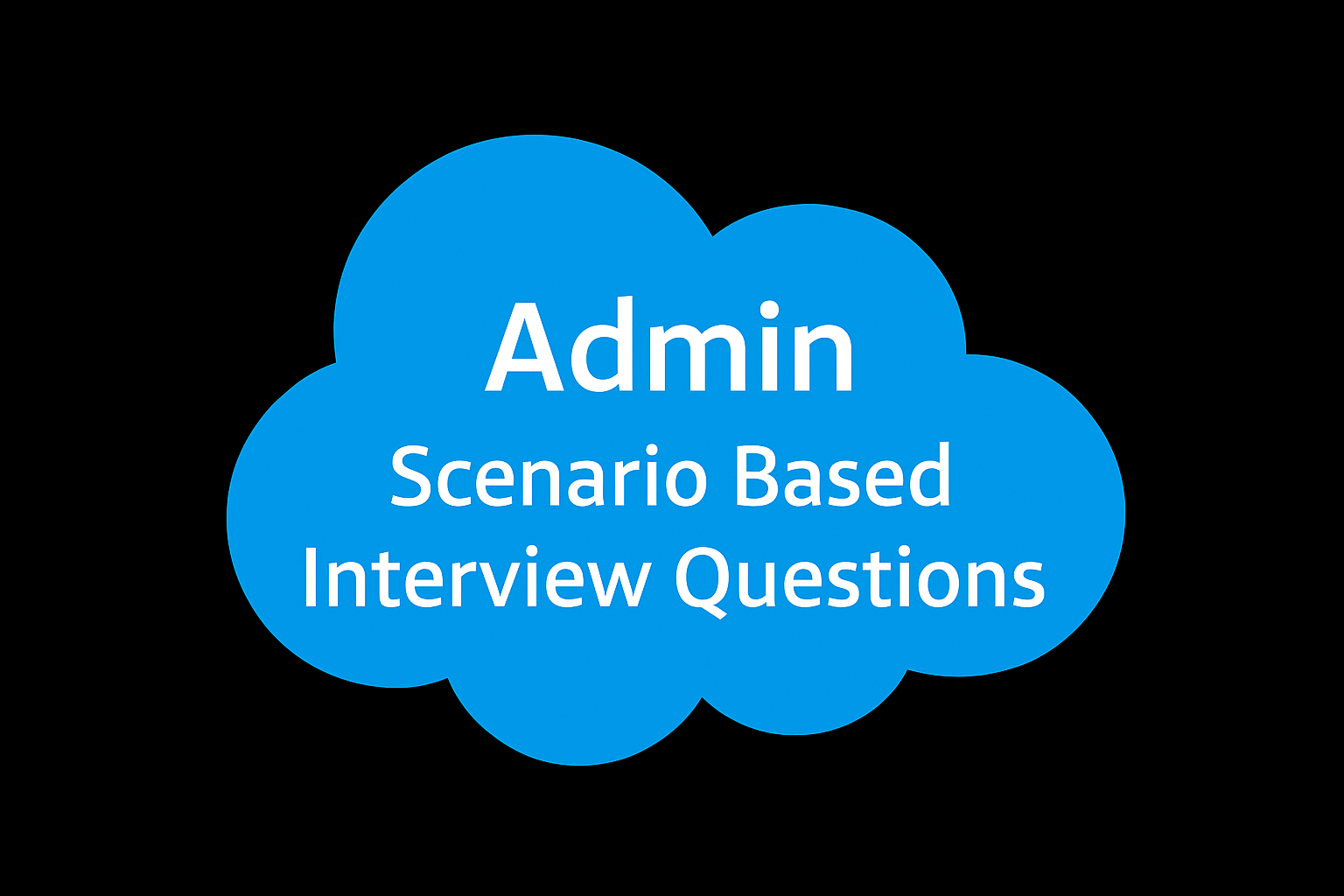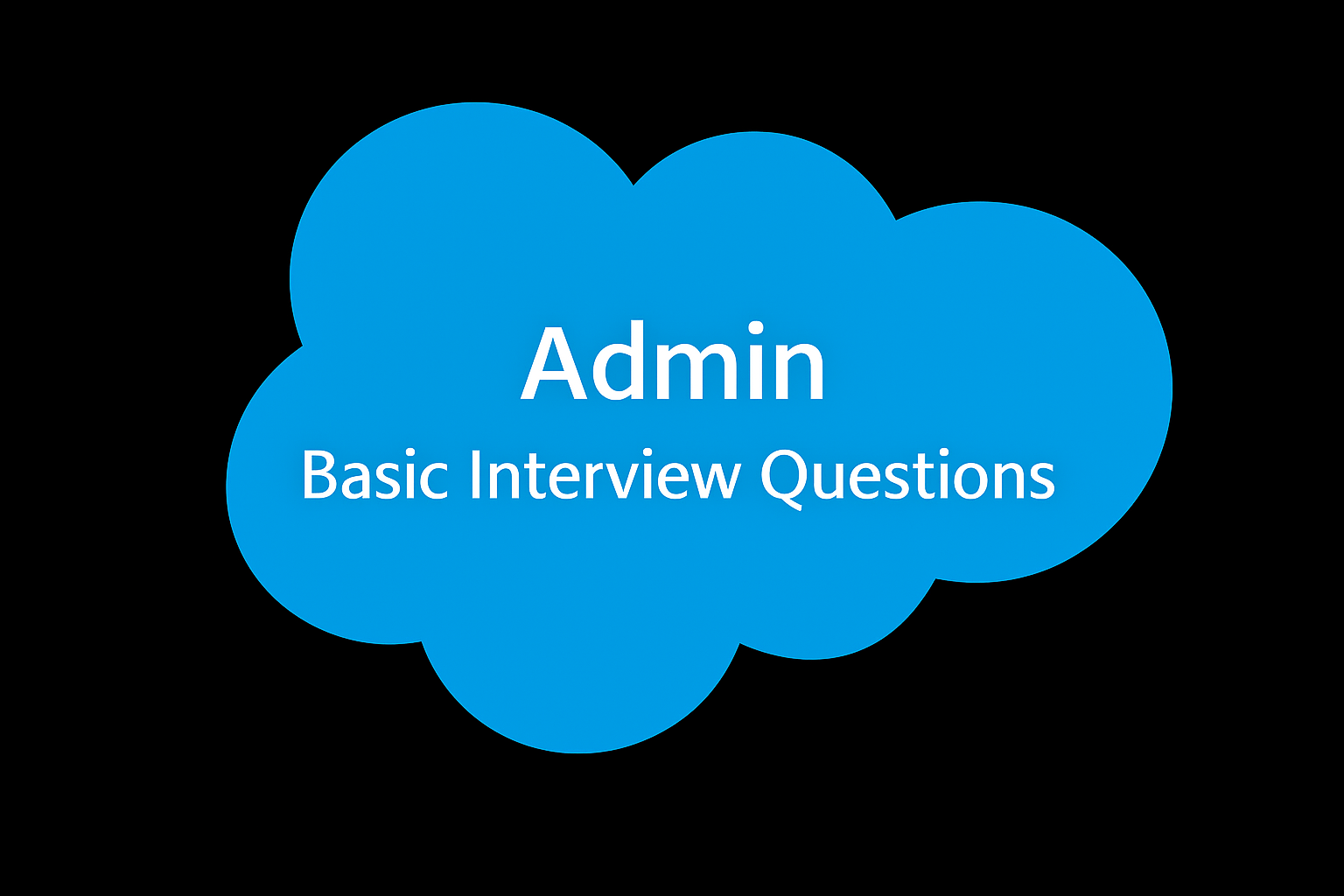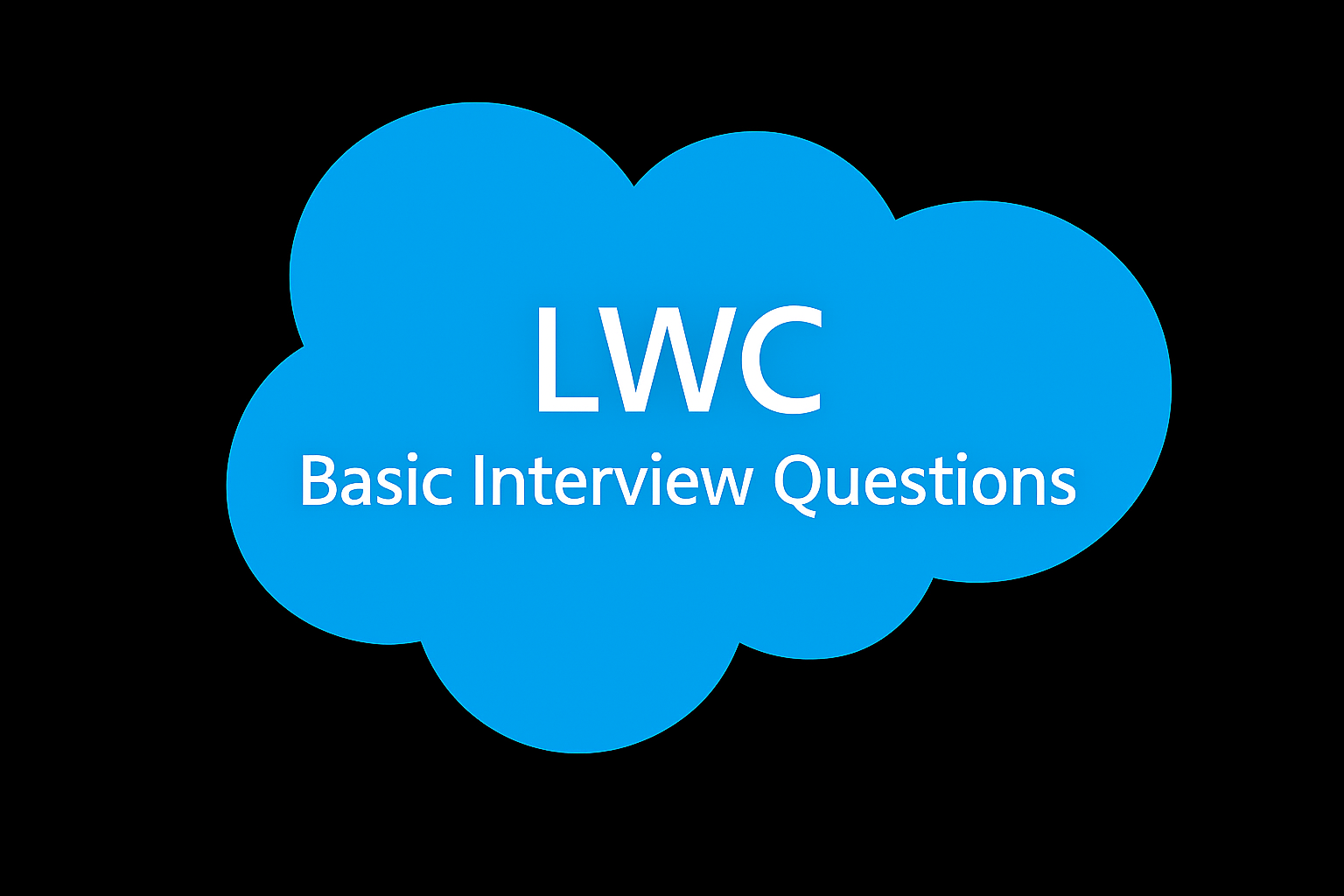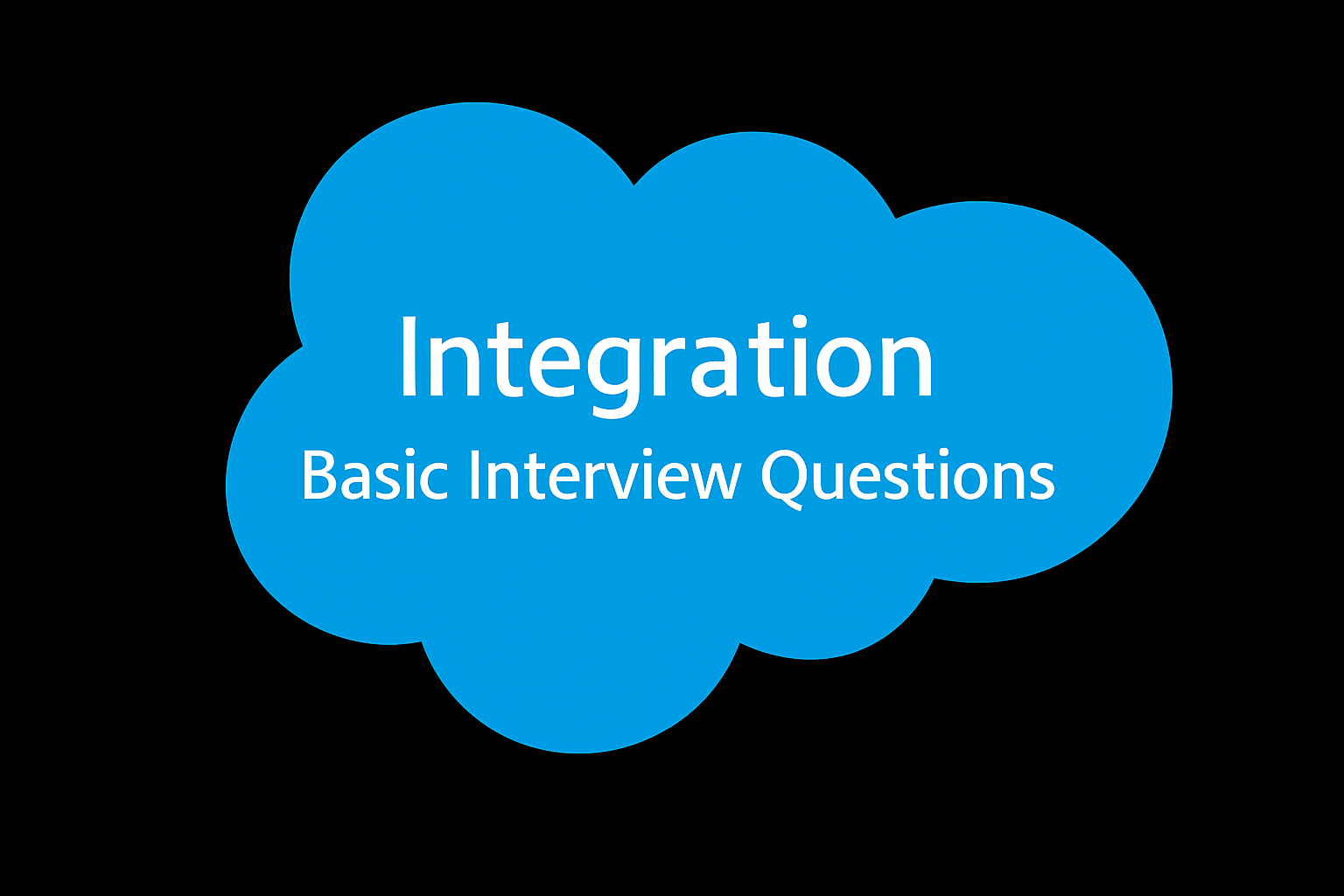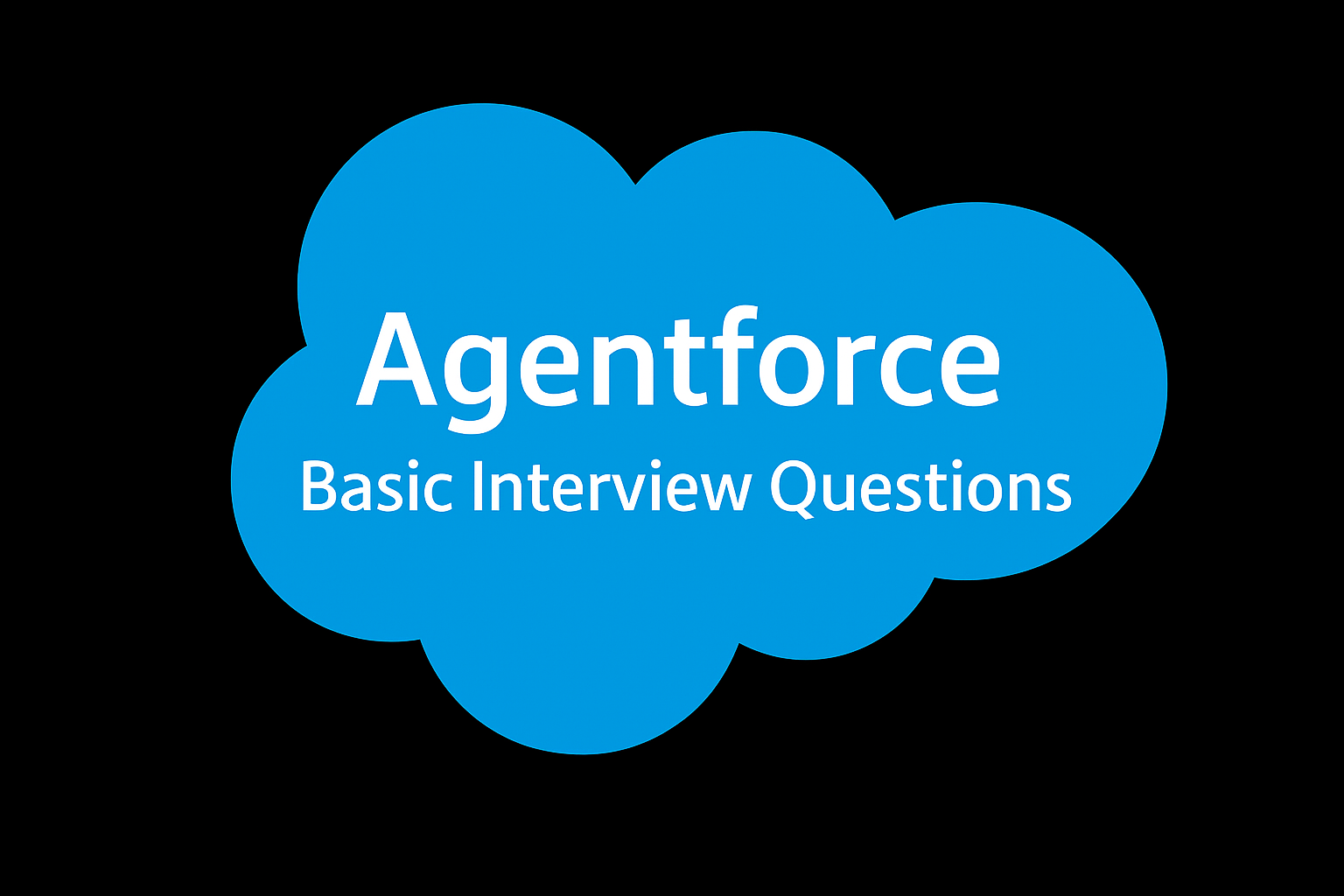Agentforce Interview Questions
-
What is AgentForce in Salesforce?
- AgentForce is Salesforce’s AI-powered automation system.
- It uses AI Agents to perform tasks based on user prompts.
- Combines LLMs + Copilot + automation tools (like Flows, Apex, etc.).
-
How is AgentForce different from traditional Salesforce automation?
- Traditional tools like Flows need clicks or buttons.
- AgentForce uses natural language commands.
- It can plan, act, and complete tasks autonomously.
-
What are AI Agents, and what do they do in Salesforce?
- AI Agents are like smart assistants inside Salesforce.
- They can understand user goals, plan steps, and take action.
Example: Drafting emails, updating records, running flows.
-
What is the role of Einstein Copilot in AgentForce?
- Copilot is the interface between the user and AI Agent.
- It listens to prompts and translates them into actions.
- Think of it as the chat-based front end of AgentForce.
-
What are “goals” in the context of an AI Agent?
- A goal is what the user wants to achieve (e.g., "send a follow-up email").
- The agent breaks the goal into steps and tasks.
- Each goal is matched to one or more Copilot Skills.
-
What is the difference between an AI Agent and an LLM?
AI Agent
LLM (Large Language Model)
Executes tasks in Salesforce
Generates text-based responses
Uses LLM + tools like Flows
Just provides smart language output
Goal-driven and task-oriented
Not aware of Salesforce environment
-
How does AgentForce improve user productivity?
- Reduces manual work (no clicks or forms).
- Understands natural language, saves time.
- Automates multi-step actions from a single prompt.
- Enables users to focus on business goals, not steps.
-
How do agents know what actions to take in Salesforce?
- They use Copilot Builder and skills catalog to match tasks.
- Based on the user prompt + system configuration.
- Agent then uses Flows, Apex, or APIs to complete actions.
-
What’s the role of user prompts in AgentForce?
- A prompt is what the user types or says (e.g., "log a call").
- It helps the agent understand the intent.
- The prompt is processed by an LLM and grounded in Salesforce data.
-
How does AgentForce differ from Flows and Process Builder?
- Flows require manual setup and specific triggers.
- AgentForce can act based on conversation and context.
- It chooses the right tools (like Flows) on its own, based on the goal.
-
What is Einstein Copilot and how does it work?
- Einstein Copilot is a conversational AI assistant inside Salesforce.
- It understands natural language prompts from users.
- It interprets the request, finds the right skill, and executes tasks like updating records or sending emails.
- Copilot acts as the interface between user and AgentForce.
-
What is Copilot Builder used for?
- It’s a setup tool to configure and manage your Copilot.
- Admins can define what Copilot can do (skills, permissions, data access).
- Enables linking Flows, Apex, APIs, and Prompt Templates to user prompts.
-
How do you configure Copilot to answer questions about Leads?
- Go to Copilot Builder > Data Access Configuration.
- Add Lead object to the Copilot’s allowed data scope.
- Define skills or actions related to Leads (e.g., “Show all open leads”).
- Use Prompt Builder to fine-tune responses.
-
What are Copilot Skills?
- Skills are reusable blocks of logic Copilot can execute.
- Can be built using Flows, Apex, or External Actions.
Example: “Create a Case”, “Send email”, “Update opportunity stage”.
Copilot chooses the skill based on user goal.
-
What are Copilot Actions and how do they relate to Flows?
- Copilot Actions are the building blocks of Skills.
- They represent steps the AI can perform (e.g., create record, send email).
- Often linked to invocable Flows or Apex methods.
- Skills = Sequence of Actions to complete a goal.
-
What is Prompt Builder, and how does it support Copilot?
- Prompt Builder helps create and manage prompts and responses.
- You define how Copilot should respond to certain types of input.
- Supports grounding, role-based customization, and testing.
Example: Customize how Copilot replies to "Show my open cases".
-
How does Copilot differ from a chatbot?
- Copilot is goal-driven, not just conversational.
- It can take real actions in Salesforce (like a smart assistant).
- Works with Flows, Apex, and data — not just text replies.
- Chatbots are often limited to FAQ-style responses.
-
Can Copilot be customized per role or app?
- Yes — you can control data access, actions, and visibility by role.
- Copilot Builder allows profile- or permission-based control.
- You can have different skills/prompts for sales vs service users.
-
How does Copilot Builder integrate with Apex, Flow, or API?
Copilot Actions can be built from:
- Flows (Invocable Flow).
- Apex (Invocable methods).
- External Services (API calls via OpenAPI spec).
- You register these in Copilot Builder > Skills & Actions.
-
How do you troubleshoot Copilot errors or unexpected behaviour?
- Use Copilot Debug Mode to trace steps taken.
- Check Skill logs, Prompt history, and Apex/Flow debug logs.
- Validate if required permissions or data access are missing.
- Adjust Prompt Builder settings or Flow logic if needed.
-
What is an LLM, and how does it power Copilot?
- LLM = Large Language Model (e.g., GPT, Claude, etc.).
- It understands and generates human-like responses.
- Copilot uses an LLM to interpret user prompts like “Update this opportunity.”
- It turns natural language into actions, queries, or instructions.
-
What’s the role of prompts in communicating with LLMs?
- A prompt is the text instruction or question given to the LLM.
- It helps the LLM understand what the user wants.
- Example: “Send follow-up email to all open leads.”
- A well-written prompt gives clear intent and context.
-
How do you structure a good prompt for Copilot?
- Be clear and specific (e.g., "Update stage of closed-won opportunities”).
- Use action words like “create,” “show,” “update,” “summarize.”
- Add filters or conditions (e.g., “only for this month”).
- Avoid vague instructions like “Do it” or “Handle everything.”
-
What is Prompt Grounding in Salesforce AI?
- It’s the process of connecting AI to real Salesforce data.
- Helps ensure the AI uses accurate, up-to-date information
- Prevents the model from guessing or hallucinating.
Example: Instead of generating a fake lead count, it queries actual lead records.
-
How is Prompt Builder different from Prompt Templates?
Prompt Builder
Prompt Template
Admin tool to manage custom prompts
Predefined format or structure for prompting
Supports role-based, skill-based prompts
Used inside Prompt Builder or Copilot
Interactive and editable
Static reference models
-
What are some examples of task-oriented prompts?
- “Create a new Case for this customer.”
- “Summarize last 3 meetings with Acme Corp.”
- “Update all Opportunities over $10K to stage ‘Proposal’.”
- “Send follow-up email to attendees from Hyderabad summit.”
-
What are hallucinations in AI, and how are they avoided in Salesforce?
- Hallucinations = AI makes up incorrect or fake information.
Salesforce avoids this using:
- Prompt grounding (use real data).
- Trust Layer (enforces permissions).
- RAG (fetches actual data before answering).
-
What is Retrieval-Augmented Generation (RAG)?
- A method where AI retrieves real data before generating a response.
- Combines search + generation = more accurate answers.
- Used by Copilot to avoid hallucinations.
Example: Copilot finds actual leads and then summarizes them.
-
How does Copilot use LLM + enterprise data safely?
- It uses the Einstein Trust Layer to enforce user permissions.
- Data grounding and RAG ensure accurate, secure data usage.
- Copilot only responds with data the user has access to.
- Tokens and APIs are protected via Shield, Field-level Security, etc.
-
Can you build your own LLM in Salesforce?
- Not directly inside Salesforce.
- You can integrate external LLMs using APIs (e.g., OpenAI, Anthropic).
- Salesforce provides its own trusted LLMs via Copilot.
- Customization is done using Prompt Builder, Skills, and Actions, not model training.
-
What is a Skill in Copilot, and how is it different from a Flow?
- A Skill is a task or goal Copilot knows how to perform.
- It uses Flows, Apex, APIs, or Actions under the hood.
- A Flow is a tool to automate logic; a Skill wraps it with intent and AI context.
- Skills are selected by Copilot, Flows must be manually triggered otherwise.
-
How do you build a multi-step task in Copilot?
- Use Copilot Builder to create a Skill.
- Link multiple Copilot Actions (like Flow steps or API calls).
- Define the sequence and logic in the Skill config.
- Example: "Create Opportunity → Assign Owner → Send Email" = one Skill.
-
What are user Goals, and how are they converted into tasks?
- A goal is what the user types/says (e.g., “Follow up with all leads”).
- Copilot maps that goal to a Skill based on prompt matching.
- The Skill contains Actions (Flows or logic) to complete the goal.
- Copilot handles the conversion automatically using LLM + grounding.
-
What’s the difference between a Skill and an Action?
Skill
Action
Represents the overall task or intent
A step or function within a Skill
Example: "Send Renewal Email"
Example: "Get Contacts", "Send Email"
Skills contain one or more actions
Actions are built from Flows, Apex, APIs
-
How do you debug a Skill that’s not completing properly?
- Use Copilot Debug Mode (in Setup or Dev tools).
- Check logs for the Skill and its linked Actions.
- Review prompt inputs, output, and Flow errors.
- Use Flow debug logs or Apex logs for deeper issues.
-
How does Copilot choose which Skill or Flow to use?
Based on the user prompt, Copilot matches to a Skill using:
- Prompt content
- Intent mapping via Prompt Builder
- Role or app context
- If multiple matches, Copilot picks the best fit or asks for clarification.
-
How do you reuse existing Flows in Copilot Actions?
- In Copilot Builder, create a Copilot Action that references the Flow.
- The Flow must be invocable and follow required input/output format.
- You can use the same Flow in multiple Skills across apps.
- This ensures modularity and reusability.
-
What are Tooling Actions vs User-Defined Actions?
Tooling Actions
User-Defined Actions
Prebuilt Salesforce system actions
Custom Flows, Apex, or External APIs
Example: “Search records”
Example: “Send Welcome Email via Flow”
Not customizable
Fully customizable in Copilot Builder
-
What happens if multiple Skills match a user goal?
- Copilot uses confidence scoring to choose the best match.
- If the match is unclear, it may ask clarifying questions.
- Admins can define priority or conditions in Prompt Builder.
Example: Two "send email" Skills → Copilot may ask "For which object?"
-
Can Skills include Apex code, APIs, or custom components?
- Yes.
Skills can call:
- Apex Methods (invocable)
- External APIs (via External Services or Apex callouts)
- Custom components via Actions or Flow subflows
- This makes Skills extensible and powerful for any use case
-
What is Retrieval-Augmented Generation (RAG)?
- RAG is an AI method that retrieves real data before generating a response.
- It improves accuracy and trust in AI outputs.
- Copilot uses RAG to pull real Salesforce records before replying.
- This avoids “hallucinations” or made-up answers.
-
How does Copilot use RAG to pull Salesforce data?
When a user enters a prompt, Copilot uses RAG to:
- Understand the prompt via LLM.
- Query Salesforce data (e.g., Leads, Opportunities).
- Use the result to build an accurate response.
- All this happens in real time and securely.
-
What is the Einstein Trust Layer?
- A protective layer that ensures Copilot respects Salesforce security rules.
- Enforces field-level, object-level, and record-level permissions.
- Filters what Copilot can see or return based on user access.
- Prevents Copilot from leaking sensitive or restricted data.
-
How does the Trust Layer help with data security in Copilot?
- It ensures Copilot only returns data the user is allowed to view.
- Applies all sharing rules, profile-level access, and org security policies.
- Works with RAG to filter both what’s retrieved and what’s shown.
- Protects against accidental exposure of private information.
-
What is data grounding in the context of AgentForce?
- Grounding means connecting the LLM to actual business data.
- Ensures the AI doesn’t “guess” but uses factual info from Salesforce.
Example: Instead of generating a random opportunity count, Copilot queries Salesforce.
-
How does Copilot connect to Data Cloud?
- Copilot can use Data Cloud as a source of unified, real-time data.
- Data Cloud brings together external, CRM, and 1st/3rd-party data.
- RAG uses this data to ground prompts across sources, not just CRM.
- Enables cross-cloud, customer-wide insights.
-
Can Copilot use external data for grounding?
- Yes — if data is brought into Data Cloud or made available via External Services.
- RAG can be configured to pull from custom connectors or external APIs.
- All external data must comply with Trust Layer rules and permissions.
- Helps in 360° customer view and AI enrichment.
-
How do you control which records Copilot can access?
- Controlled by user’s profile, sharing rules, and field-level security.
- Admins configure data access in Copilot Builder > Data Access Settings.
- Trust Layer applies this access control during grounding.
- Also customizable via custom prompts and filters.
-
What happens if a user prompt requests unauthorized data?
- Copilot will not return the data if access is restricted.
- It may return a generic message like “You don’t have permission.”
- The Trust Layer silently filters out restricted results.
- Keeps the experience secure without exposing sensitive info.
-
What is the impact of field-level security in RAG responses?
- Fields hidden by FLS are automatically excluded from Copilot’s answer.
- Even if the record is visible, sensitive fields (like Salary or SSN) won't show.
- RAG respects all FLS, object permissions, and role-based access.
- This keeps Copilot answers safe, filtered, and compliant.
-
How is user access enforced in AgentForce?
- AgentForce respects existing Salesforce security settings.
- Enforces object, field, and record-level access (OWD, roles, sharing rules).
- Works through the Einstein Trust Layer to ensure safe responses.
- Copilot only acts within what the user is allowed to do/view.
-
Can Copilot access records the user isn’t allowed to see?
- No — Copilot cannot access or show restricted data.
- Trust Layer ensures all responses are filtered by user’s permissions.
- If data is restricted, Copilot may return a limited or blank response.
- This prevents data leakage or exposure.
-
What is the Einstein Trust Layer and how does it enforce permissions?
- It’s a security layer between Copilot and Salesforce data.
Checks every prompt response for:
-
- Object/field access
- Sharing rules
- FLS and org-wide settings
- Filters results so users only see data they’re authorized to access.
-
How do Shield or Field Audit Trail integrate with AI usage?
- Salesforce Shield adds encryption, monitoring, and event logging.
- Field Audit Trail tracks changes made via Copilot or AI agents.
- Helps organizations meet compliance, legal, and audit requirements.
- Useful for data access review and history tracking.
-
What governance settings are available for Copilot behavior?
Admins can control:
- Who can use Copilot (via Permission Sets).
- Which objects/actions are allowed.
- Which prompts and data scopes are enabled.
- Copilot can be scoped by profile, app, or skill visibility.
-
How do you restrict Copilot to only run certain skills for specific users?
- Use Prompt Builder or Copilot Builder to limit skill availability.
- Apply Permission Sets or role-based conditions.
- Skills can be hidden if user lacks required object or field access.
- Ensures Copilot runs only authorized business logic.
-
What is Audit Logging for AgentForce actions?
- Audit logs record what Copilot did, when, and for whom.
- Tracks AI-driven actions, changes, or record updates.
- Stored securely for compliance, rollback, or incident review.
- Can be extended with custom logging via Apex/Flows.
-
How do you track what an Agent did on behalf of a user?
- Use Audit Trail, Field History Tracking, or Custom Logs.
- Copilot actions are executed as the user, maintaining accountability.
- Admins can trace activities by timestamp, object, or user ID.
- Helps with troubleshooting and compliance audits.
-
Can you disable Copilot features for some profiles?
- Yes — use Permission Sets or profile-level access control.
You can restrict:
-
- Copilot access completely.
- Specific Skills or data objects.
- Prompt visibility based on role/app.
- Ensures Copilot access is tailored to business need.
-
What are some best practices for Copilot security reviews?
- Review data access rules (OWD, FLS, role hierarchy).
- Configure Prompt Builder with clear intent limits.
- Enable audit and monitoring (Shield, Login History, etc.).
- Use Named Credentials and OAuth for external calls.
- Test Copilot with non-admin users to ensure proper access control.
-
How would you configure Copilot to update an Opportunity stage based on a user request?
- Create a Copilot Skill with an invocable Flow or Apex to update the Opportunity.
- Use Prompt Builder to map phrases like “Update stage to Proposal.”
- Enable access to the Opportunity object in Copilot Builder.
- Ensure record-level access is enforced by the Trust Layer.
-
How do you automate the sending of renewal emails via AgentForce?
- Build a Flow to generate and send the renewal email.
- Wrap it in a Copilot Skill and map prompts like “Send renewal email to this customer.”
- Use dynamic email templates and auto-fill fields via Flow inputs.
- Optionally, add a confirmation step before sending.
-
How would you use Copilot to summarize a Contact's history?
- Create a Skill that uses Apex or Flow to query activity history, cases, and emails.
- Format the response using Prompt Templates.
- Ground the summary in actual Salesforce data (via RAG).
Example Prompt: “Summarize all recent interactions with John Doe.”
-
Can Copilot create and relate multiple records in one prompt?
- Yes — use a Skill with multiple invocable actions or subflows.
- Example: Create a Contact → link to Account → create Task → send email.
- Copilot handles multi-step logic using goal → actions mapping.
- All steps must respect user’s CRUD & sharing access.
-
How do you handle approvals using Copilot?
- Create a Flow that starts a standard approval process.
- Expose it via a Skill: “Send this Opportunity for approval.”
- Add branching logic if manager approval is needed
- Copilot submits on behalf of the user with real-time status feedback.
-
What’s your approach to building a “Sales Assistant” experience in Copilot?
- Define top sales tasks:
- “Show my pipeline,”
- “Remind me to follow up,”
- “Send quote,” etc.
- Build Skills for each task using Flows, Apex, or External Services.
- Customize prompts, permissions, and visibility by sales role.
- Include daily summaries or smart nudges via scheduled prompts.
- Define top sales tasks:
-
How would you let a user log a case, attach a file, and notify a manager via one prompt?
- Create a Skill with multiple steps:
- Create a Case
- Use File Upload Action (standard in Flows)
- Send Email or Notification to Manager
- Map prompts like: “Log a high-priority support case with details.”
- Use dynamic branching to guide the user for file or notes.
- Create a Skill with multiple steps:
-
Can Copilot be integrated into Experience Cloud for customer service?
- Yes — Copilot can be embedded in Experience Cloud sites.
- You can expose limited Skills for customers (e.g., check case status).
- Must ensure data and security settings are carefully scoped.
- Use guest user setup, Shield, and FLS control for public Copilot usage.
-
How would you measure Copilot’s effectiveness in a sales process?
- Track metrics like:
- of prompts used
- Avg. task completion time
- Errors or retries
- Use Audit Logs, Prompt Analytics, or custom Flow logs.
- Gather user feedback and compare with manual process baselines.
- Track metrics like:
-
What steps do you follow to roll out Copilot to an entire department?
- Pilot launch with small user group (1–2 use cases).
- Refine Skills and Prompts based on feedback.
- Set up training + documentation for broader rollout.
- Assign Permission Sets by role.
- Monitor usage via Copilot dashboards and audit logs.
-
What is Agentic AI in Salesforce?
- Agentic AI = AI that can think, decide, and act like a smart assistant.
- In Salesforce, it means AI agents that interpret user goals and complete tasks.
- Uses LLMs + tools (Flow, Apex, RAG) to take actions, not just give answers.
Example: Copilot that can plan and execute multi-step tasks like a human assistant.
-
How does Agentic AI differ from traditional automation?
- Traditional automation (Flows, Process Builder) = predefined rules and triggers.
- Agentic AI = goal-driven, not rule-driven.
- It can choose tools, ask for more info, and adapt.
- Acts based on context and user intent, not just hardcoded logic.
-
Can AgentForce chain multiple agents together to achieve goals?
- Yes — agents can execute Skills made of multiple steps/actions.
- They can delegate tasks to sub-skills or subprocesses.
- This is like chaining Flows + Apex + APIs to complete complex workflows.
- Example: One agent handles onboarding → another sends welcome email.
-
How does the AI decide which Flow or Skill to run?
- Based on the user’s prompt and intent.
- Uses Prompt Builder + AI scoring to match a Skill.
- Evaluates context, available data, and access rights.
- If unsure, may ask for clarification before acting.
-
Can Agents ask clarifying questions before acting?
- Yes — if the prompt is vague or has missing info.
- Copilot can prompt: “Which opportunity do you mean?”
- Supports follow-up questions to refine the goal.
- This makes interactions more accurate and human-like.
-
What happens if there’s not enough information in the prompt?
- Copilot will:
- Ask follow-up questions, OR
- Show options to select, OR
- Say “I need more info to complete this task.”
- It avoids guessing to prevent wrong actions.
- This is handled through LLM + prompt grounding logic.
- Copilot will:
-
What is AI self-correction, and is it supported in Salesforce?
- Self-correction = AI detects its own mistakes and adjusts.
Example: “Oops, I created the wrong record — let me fix it.”
- Currently limited in Salesforce (as of 2025), but partially supported through:
- Prompt chaining,
- Retry logic,
- Skill fallback handling.
-
Can Copilot learn from user interactions over time?
- Not natively (Copilot is stateless for now).
- However, admins can analyze usage and refine:
- Prompts
- Skill logic
- Custom actions
- Salesforce roadmap includes feedback loop support in future releases.
-
How does Salesforce avoid hallucination while being dynamic?
- Uses RAG (Retrieval-Augmented Generation) to pull real data.
- Applies the Einstein Trust Layer for secure, grounded responses.
- Copilot only shows data user has access to, not LLM guesses.
- Combines AI generation + strict data filtering.
-
What are future trends in Agentic AI within Salesforce?
- Personalized Copilot experiences by role or industry.
- Closed-loop learning: Copilot adapts to user feedback.
- Agent collaboration: Multiple agents handling end-to-end processes.
- External AI integrations: Custom LLMs, voice, generative UI.
- Metrics-based optimization: Auto-suggested improvements to Skills.
